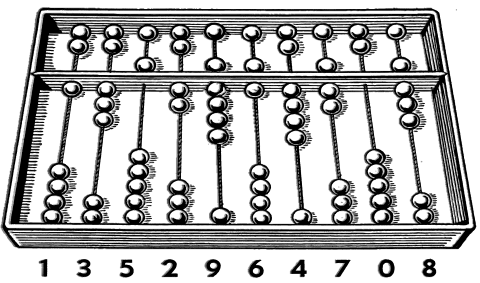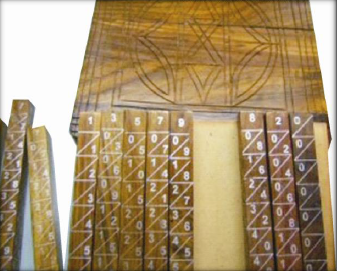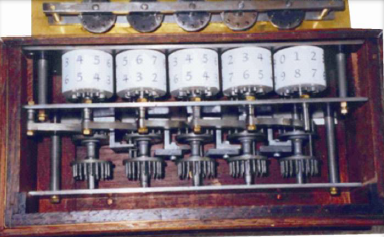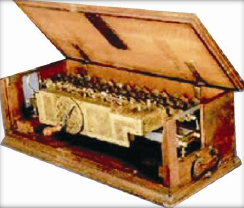Information Technology Tools and Network Basis
Introduction to Computer Question & Answer
Question : 1
What do you mean by word Computer, Explain it with its features.
Answer :
Question : 2
What is volatile memory?
Answer :
RAM is known as Volatile Memory because when we switch off the computer its data is vanished.
Question : 3
Define each of the following:
(a) byte
(b) kilobyte
(c) megabyte
(d) gigabyte
(e) terabyte
Answer :
(a) byte: This is the unit of memory in computer. 1 byte = 8 bits
(b) kilobyte: This is the unit of memory in computer. 1 kilobyte = 1024 bytes
(c) megabyte: This is the unit of memory in computer. 1 megabyte = 1024 kilobytes
(d) gigabyte: This is the unit of memory in computer. 1 gigabyte = 1024 megabytes
(e) terabyte: This is the unit of memory in computer. 1 terabyte = 1024 gigabytes.
Question : 4
State the basic units of computer. Name the subunits that make up the CPU, and give the function of each of the unit.
Answer :
Basic units of computer are Input Unit, Central Processing Unit and Output Unit. Sub unites of
CPU are Arithmetical Logical Unit(ALU), Control Unit (CU) and Memory Unit(MU).
Question : 5
What is the function of memory? What are its measuring units?
Answer :
The computer memory is a temporary storage area. It holds the data and instructions that
the Central Processing Unit (CPU) needs. Before a program can run, the program is loaded from
some storage medium into the memory. This allows the CPU direct access to the program. Its
measuring units are byte, kilobyte, megabyte, gigabyte, terabyte etc.
Question : 6
Why is primary memory termed as "destructive write" memory but "non-destructive read" memory?
Answer :
The primary memory is called destructive write because the data enter here are temporary.
That‟s why your RAM gets cleared after every restart.
Question : 7
What is the role of CPU of a mobile system?
Answer :
A mobile processor is found in mobile computers and cellphones.
A CPU chip is designed for portable computers, it is typically housed in a smaller chip package,
but more importantly, in order to run cooler, it uses lower voltages than its desktop counterpart
and has more sleep mode capability. A mobile processor can be throttled down to different power
levels or sections of the chip can be turned off entirely when not in use. Further, the clock
frequency may be stepped down under low processor loads. This stepping down conserves power
and prolongs battery life.
Question : 8
What is SoC? how it is different from CPU? Why is it considered a better development?
Answer :
A system on a chip (SoC) combines the required electronic circuits of various computer components onto a single, integrated chip (IC). SoC is a complete electronic substrate system that may contain analog, digital, mixed-signal or radio frequency functions. Its components usually include a graphical processing unit (GPU), a central processing unit (CPU) that may be multi-core, and system memory (RAM).
Because SOC includes both the hardware and software, it uses less power, has better
performance, requires less space and is more reliable than multi-chip systems. Most system-on chips today come inside mobile devices like smartphones and tablets. These are considered a
better development because of their small size and speed capability.
Question : 9
Briefly explain the basic architecture of a computer.
Answer :
Computer organization refers to logical structure of a computer describing how its components
are connected to one another, how they affect one another‟s functioning and contributes to
overall performance of computer.
Computers follow the „IPO‟ principal i.e.
Input Process Output
(That means a certain input is processed to
Generate specific output)
Question : 10
What is the function of CPU in a computer system? What are its sub units?
Answer :
`The central processing unit (CPU) of a computer is a piece of hardware that carries out the instructions of a computer program. It performs the basic arithmetical, logical, and input/output operations of a computer system. The CPU is like the brains of the computer - every instruction, no matter how simple, has to go through the CPU. So let's say you press the letter 'k' on your keyboard and it appears on the screen - the CPU of your computer is what makes this possible. The CPU is sometimes also referred to as the central processor unit, or processor for short. So when you are looking at the specifications of a computer at your local electronics store, it typically refers to the CPU as the processor. Its sub units are:
(i) Control Unit
(ii) Arithmetical and Logical Unit (ALU)
(iii) Memory Unit
Question : 11
What functions are performed by the control unit?
Answer :
The CU controls and guides the interpretation, flow and manipulation of all data and information.
CU sends control signals until the required operations are done properly by ALU and memory.
Another function of CU is the program execution. It means carrying out all the instructions stored
in the program. CU gets program instruction from the memory and executes them one after the
other. CU acts as a supervisor by controlling and guiding the operation taking place.
Question : 12
Distinguish between CPU and ALU?
Answer :
Difference Between ALU and CPU is that arithmetic logic unit (ALU), another component of the processor, performs arithmetic, comparison, and other operations. While Processor also central processing unit (CPU), interprets and carries out the basic instructions that operate a computer.
The main difference between CPU and ALU is that the CPU is an electronic circuit that
handles instructions to operate the computer while the ALU is a subsystem of the CPU that
performs arithmetic and logical operations.
Question : 13
What is the function of output unit in a computer system?
Answer :
Input devices are the hardware that give computers instructions. Output devices relay the
response from the computer in the form of a visual response (monitor), sound (speakers) or
media devices (CD or DVD drives). The purpose of these devices is to translate the machine's
response to a usable form for the computer user.
Question : 14
Distinguish between internal and external memory.
Answer :
Internal memory is usually chips or modules that you attach directly to the
motherboard. Internal Memory is a circular disc that continuously rotates as the computer
accesses its data. External memory often comes in the form of USB flash drives; CD, DVD, and
other optical discs; and portable hard drives.
Question : 15
What are RAM and ROM? How are they alike? How are they different? What are PROM, EPROM, EEPROM?
Answer :
A ROM chip is a non-volatile storage medium, which means it does not require a constant source of power to retain the information stored on it. A RAM chip is volatile, which means it loses any information it is holding when the power is turned off. Both of them are known as primary memory as they can directly work with CPU.
- Read Only Memory (ROM)
- Programmable Read Only Memory (PROM)
- Erasable Programmable Read Only Memory (EPROM)
- Electrically Erasable Programmable Read Only Memory (EEPROM)
Question : 16
What are major functional components of a mobile system?
Answer :
Major functional components of a mobile system are-
(i) Mobile Processor
a. Communications Processing Unit
b. Application Processing Unit
c. GPU (Graphics Processing Unit)
(ii) SoC (System on a chip)
(iii) Display Subsystem
a. Display Screen
b. Touch Sensitive Interface
c. Touch Sensitive Keyboards
(iv) Camera Subsystem
(v) Mobile System Memory
a. RAM
b. ROM
(vi) Storage
(vii) Power Management Subsystem
Question : 17
What is the role of Power Management Unit in a mobile system?
Answer :
This subsystem is responsible for providing power to a mobile system. The mobile systems work on limited power provided through an attached battery unit. This system has a battery management system that works with a battery charger and a battery unit and provides power to the mobile system in required form.
It also contains a collection of different functions like battery charging, monitoring and
supplying many different voltages these systems require. It also contains software controlled
turn-on and turn-off feature to optimize the power consumption and battery life.
Question : 18
What is GPU? How is it useful?
Answer :
Graphics Processing Unit assists the CPU by handling the visuals, other graphically-rich
applications. In short, GPU handles all graphics-related chores of a mobile CPU.
Question : 19
Name at least four early calculating devices.
Answer :
1) Abacus : Abacus was discovered by the Mesopotamians in around 3000 BC. An abacus consisted of beads on movable rods divided into two parts. (Fig-1) Addition and multiplication of numbers was done by using the place value of digits of the numbers and position of beads in an abacus.

The Chinese further improved on the abacus so that calculations could be done more easily. Even today abacus is considered as an apt tool for young children to do calculations. In an abacus, each row is thought of as a ten’s place. From right to left , row no-1 represents the one’s column and the second column represents ten’s place. The third column represents the hundred’s place and so on. The starting position of the top beads (representing the value of five) is always towards the top wall of the abacus while the lower beads (representing the value of one) will always be pushed towards the lower wall as a starting position.
2) Napier’s Logs and Bones : The idea of logarithm was developed by John Napier in 1617. He devised a set of numbering rods known as Napier’s Bones through which both multiplication and division could be performed. These were numbered rods which could perform multiplication of any number by a number in the range of 2-9. There are 10 bones corresponding to the digits 0-9 and there is also a special eleventh bone that is used to represent the multiplier. By placing bones corresponding to the multiplier on the left side and the bones corresponding to the digits of the multiplicand on the right , the product of two numbers can be easily obtained.

3) Pascaline : Blaise Pascal, a French mathematician invented an adding machine in 1642 that was made up of gears and was used for adding numbers quickly. This machine was also called Pascaline and was capable of addition and subtraction along with carry-transfer capability. It worked on clock

work mechanism principle. It consisted of various numbered toothed wheels having unique position values. The addition and subtraction operations was performed by controlled rotation of these wheels.
4) Leibnitz’s Calculator : In 1673 Gottfried Leibnitz, a German mathematician extended the capabilities of the adding machine invented by Pascal to perform multiplication and division as well. The multiplication was done through repeated addition of numbers using a stepped cylinder each with nine teeth of varying lengths.

Question : 20
Define analog computers
Answer :
An analog computer works on varying physical quantities. The data input to a computer is continuous in nature irrespective of the variations in input and the results are obtained after comparison.
For example, meter scale, thermometer etc.
Question : 21
What is a digital computer?
Answer :
A digital computer accepts data in the binary form:
Zero (0) means OFF or low signal
One (1) means ON or high signal
It gives results in terms of digits. All personal computers and laptops are digital in nature.
For example, digital watches, calculators etc.
Question : 22
Define mainframe computers
Answer :
Answer
Mainframe computers are large computers with huge storage capacities. These computers are generally used in large industries, banking organizations, advanced scientific research centers, etc.
Question : 23
What is meant by C++ (as a computer language)?
Answer :
- C++ is an object oriented programming (OOP) language.
- This high-level language is derived from C language and it applies object oriented features of Simula 67.
- C++ is more popular among software professionals as it allows the user to perform long operations efficiently in short forms.
Question : 24
What is an assembler?
Answer :
Assembler is a software which is used to convert a program written in assembly level language into a machine level language. It helps a computer to perform its basic operations
Question : 25
Differentiate between Machine Level and Assembly Level Languages
Answer :
| Machine Level Languages | Assembly Level Languages |
| Instructions are given as strings of binary digits (0s and 1s) | Instructions are given in terms of Mnemonics. |
| No OP-Code is required | Mnemonics are further coded into OP-Code. |
| It takes more time in coding instructions | It takes less time in coding instructions. |
| No translator is required for execution. | A translator is required for execution. |
Question : 26
Differentiate between High-level and Low Level Languages
Answer :
| High-level Languages | Low-level Languages |
| These languages are used to write programs in simple English and by using alphabets and numbers | These languages are used to write programs with the combination of 0s and 1s. |
| They are machine independent languages. | They are machine dependent languages. |
| They are easy to learn | They are difficult to learn. |
| Modification of programs is easy. | Modification of programs is time-consuming. |
Question : 27
Differentiate between the Compiler and Interpreter
Answer :
| Compiler | Interpreter |
| It converts the entire program into its machine code at once | It converts the entire program into its machine code line by line |
| It displays the errors of the entire program only after compilation. | It displays the errors of one line at a time during the conversion to its machine code |
| The control moves to the next line irrespective of any errors in the previous line. | The control doesn't move to the next line until the previous line is error-free. |
Question : 28
What are the limitations of machine level languages?
Answer :
The limitations of machine level languages are:
- The process of generating binary codes is very time consuming.
- There is always a chance of making mistakes during the conversion into binary codes.
- It is a machine-dependent language.
Question : 29
Enlist three features of the second generation of computers.
Answer :
Three features of the second generation of computers are as follows:
- Transistors were one of the main components used in the circuit of these computers.
- The computers were smaller in size as compared to the first generation computers.
- The processing speed of these computers increased from milliseconds to microseconds.
Question : 30
What are the advantages of high-level languages?
Answer :
- They are machine independent languages.
- They are easy to learn and help to develop programming logic.
- Programs in these languages can be easily modified.
Question : 31
State two limitations of the first generation of computers.
Answer :
Two limitations of the first generation of computers are:
- These computers were difficult to operate.
- They needed heavy air-conditioned systems because of the tremendous amounts of heat generated by the vacuum tubes.
Question : 32
Give three features of the third generation of computers.
Answer :
Three features of the third generation of computers are:
- The use of integrated circuit technology reduced the size of these computers.
- These computers could do fast calculations.
- Their capacity to hold data and information was more due to improved secondary storage devices.